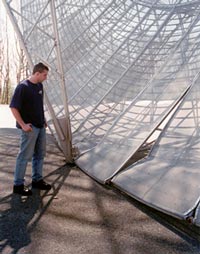SETI Searches Today.. Continued
Project SERENDIP
SETI researchers have always had trouble getting valuable radio-telescope
time for their admittedly chancy pursuits. Yet telescope time, vast quantities of
it, is what the search demands. Project SERENDIP "piggybacks" as
an extra receiver onto a radio telescope without getting in the way
of the telescope's other work.
The current version of SERENDIP is suspended high above the Arecibo
dish along with other receivers. It scans the sky for narrow-band signals
wherever it happens to get pointed. The aiming of Arecibo is controlled by
other radio astronomers working on their own projects. While SERENDIP
can't choose where it looks, it runs around the clock all year.
Since 1998 SERENDIP has been listening to 168 million radio
channels, centered on the H emission frequency
of 1,420 MHz (21 cm).
Strengths: Uses the world's largest radio telescope, scans a fair
fraction of the sky. Samples billions of stars and thousands of galaxies.
Weaknesses: No real-time followup. Weak signals could fade
in and out of detection on a time-scale of minutes due to
"interstellar scintillation". If the aliens turn their transmitter
elsewhere (or off), you can't confirm a signal.
 Project BETA
Project BETA
Since the early 1980s several sky surveys have been carried out by Paul
Horowitz of Harvard University and his graduate students, using a 26-meter
radio telescope in the town of Harvard, Massachusetts. Horowitz and his team
systematically swept the sky from declination -30° to +60° four times from
October 1995 until March 1999, when the antenna's mounting was crippled
in a wind storm (see more
here).
Project BETA scanned a wide frequency band, 1.40 - 1.72 GHz. This frequency range has been dubbed the "water hole". It is marked on either end by important emissions from hydrogen (H) and hydroxyl (OH).
Strengths:
BETA scanned 68 percent of the celestial sphere across a wide
frequency band. It used elegant methods to check interesting signals,
reject false alarms, and perform real-time followups of potential
genuine signals before fading due to interstellar scintillation could take
effect.
Weaknesses:
Insensitive to signals that drift in frequency. A small, relatively
insensitive dish.